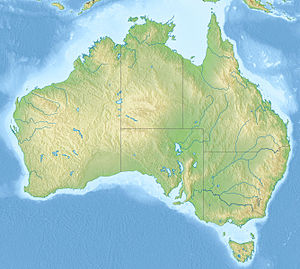Willandra Lakes
| Willandra Lakes Region | |
|---|---|
| Name as inscribed on the World Heritage List | |

Part of the Willandra Lakes system. 1) Lake Mulurulu, 2) Willandra Creek, 3) Garnpung Lake, 4) Lake Leaghur, 5) Lake Mungo, 6) Lake Arumpo, 7) Chibnalwood Lakes.
|
|
| Location | Australia |
| Type | Mixed |
| Criteria | iii, viii |
| Reference | 167 |
| UNESCO region | Asia-Pacific |
| Coordinates | 34°00′S 143°00′E / 34.000°S 143.000°ECoordinates: 34°00′S 143°00′E / 34.000°S 143.000°E |
| Inscription history | |
| Inscription | 1981 (5th Session) |
|
Location of the Willandra Lakes Region on the Australian continent
|
|
The Willandra Lakes Region is a World Heritage Site in the Far West region of New South Wales, Australia. The Willandra Lakes Region is the traditional meeting place of the Muthi Muthi, Nyiampaar and Barkinji Aboriginal tribes. The 240,000-hectare (590,000-acre) area was inscribed on the World Heritage List at the 5th Session of the World Heritage Committee in 1981 with the following inscription:
...contains a relict lake system whose sediments, geomorphology and soils contain an outstanding record of a low-altitude, non-glaciated Pleistocene landscape. It also contains an outstanding record of the glacial-interglacial climatic oscillations of the late Pleistocene, particularly over the last 100,000 years. Ceasing to function as a lake ecosystem some 18,500 years ago, Willandra Lakes provides excellent conditions to document life in the Pleistocene epoch, the period when humans evolved into their present form.
The undisturbed stratigraphic context provides outstanding evidence for the economic life of Homo sapiens sapiens to be reconstructed. Archaeological remains such as hearths, stone tools and shell middens show a remarkable adaptation to local resources and a fascinating interaction between human culture and the changing natural environment. Several well-preserved fossils of giant marsupials have also been found here.
Willandra contains some of the earliest evidence of Homo sapiens sapiens outside Africa. The evidence of occupation deposits establishes that humans had dispersed as far as Australia by 42,000 years ago. Sites also illustrate human burials that are of great antiquity, such as a cremation dating to around 40,000 years BP, the oldest ritual cremation site in the world, and traces of complex plant-food gathering systems that date back before 18,000 years BP associated with grindstones to produce flour from wild grass seeds, at much the same time as their use in the Middle East. Pigments were transported to these lakeshores before 42,000 years BP. Evidence from this region has allowed the typology of early Australian stone tools to be defined.
The Region contains important natural and cultural features including exceptional examples of past human civilization including the world's oldest cremation site. A small section of the region is protected by the Mungo National Park.
...
Wikipedia

